People & Organization: Perception, Discrimination at Maroush Group
VerifiedAdded on 2020/01/15
|13
|3703
|166
Report
AI Summary
This report delves into the organizational behavior of the Maroush Group, a chain of Lebanese restaurants in London, focusing on the challenges of managing a diverse workforce. It identifies workplace problems such as performance and national origin discrimination arising from differing employee perceptions, attitudes, and cultural backgrounds. The report explores relevant perception theories, including attribution theory, stereotyping theory, and the halo/horn effect, analyzing their impact on the workplace environment. Furthermore, it provides recommendations for managing diversity and overcoming discrimination, emphasizing the importance of creating a healthy and inclusive work environment to improve employee relations and overall business success. The report utilizes case studies, illustrations, and theoretical frameworks to provide a comprehensive overview of the issues and propose practical solutions for human resource managers.
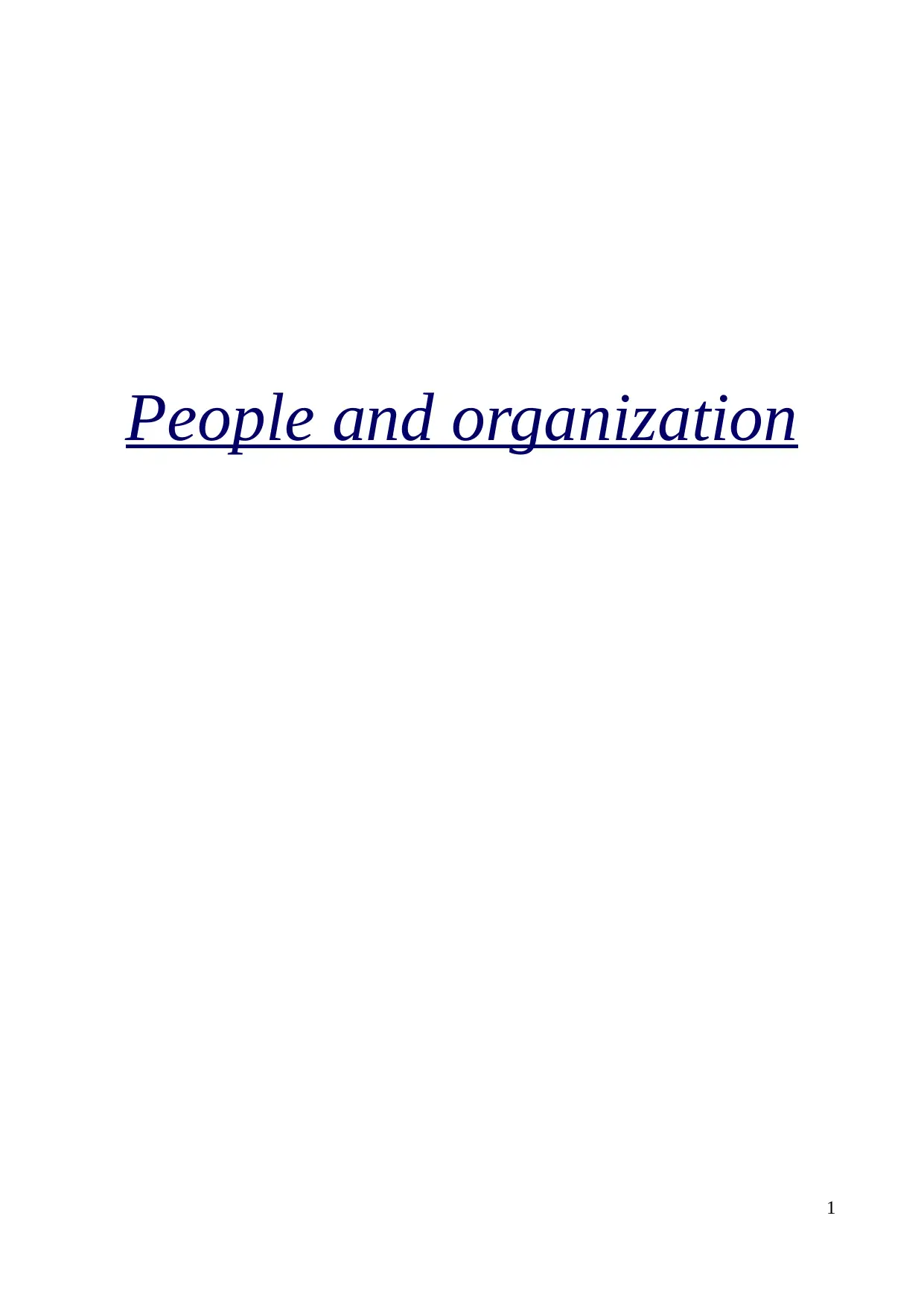
People and organization
1
1
Paraphrase This Document
Need a fresh take? Get an instant paraphrase of this document with our AI Paraphraser
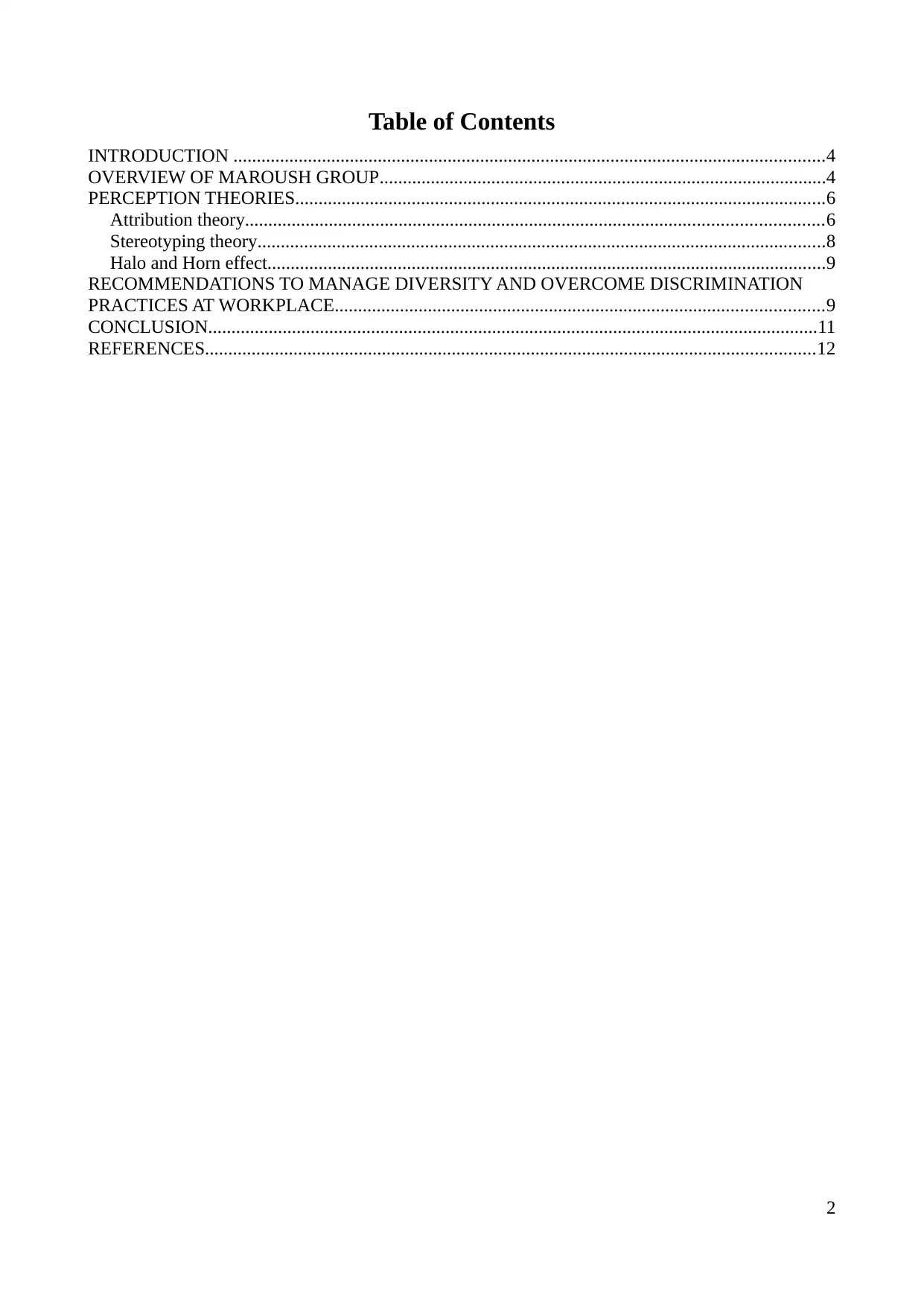
Table of Contents
INTRODUCTION ...............................................................................................................................4
OVERVIEW OF MAROUSH GROUP................................................................................................4
PERCEPTION THEORIES..................................................................................................................6
Attribution theory............................................................................................................................6
Stereotyping theory..........................................................................................................................8
Halo and Horn effect........................................................................................................................9
RECOMMENDATIONS TO MANAGE DIVERSITY AND OVERCOME DISCRIMINATION
PRACTICES AT WORKPLACE.........................................................................................................9
CONCLUSION...................................................................................................................................11
REFERENCES...................................................................................................................................12
2
INTRODUCTION ...............................................................................................................................4
OVERVIEW OF MAROUSH GROUP................................................................................................4
PERCEPTION THEORIES..................................................................................................................6
Attribution theory............................................................................................................................6
Stereotyping theory..........................................................................................................................8
Halo and Horn effect........................................................................................................................9
RECOMMENDATIONS TO MANAGE DIVERSITY AND OVERCOME DISCRIMINATION
PRACTICES AT WORKPLACE.........................................................................................................9
CONCLUSION...................................................................................................................................11
REFERENCES...................................................................................................................................12
2
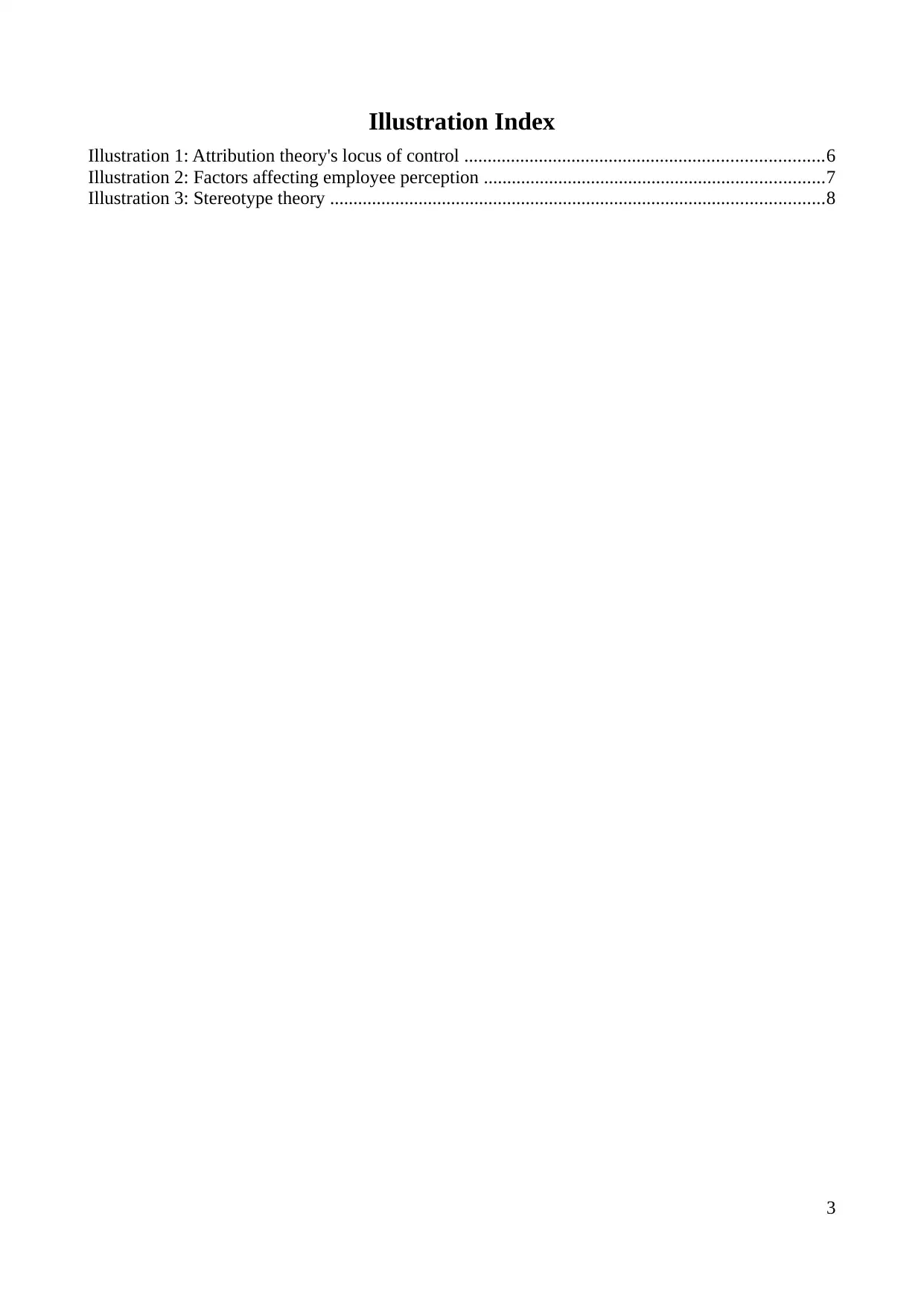
Illustration Index
Illustration 1: Attribution theory's locus of control .............................................................................6
Illustration 2: Factors affecting employee perception .........................................................................7
Illustration 3: Stereotype theory ..........................................................................................................8
3
Illustration 1: Attribution theory's locus of control .............................................................................6
Illustration 2: Factors affecting employee perception .........................................................................7
Illustration 3: Stereotype theory ..........................................................................................................8
3
⊘ This is a preview!⊘
Do you want full access?
Subscribe today to unlock all pages.

Trusted by 1+ million students worldwide
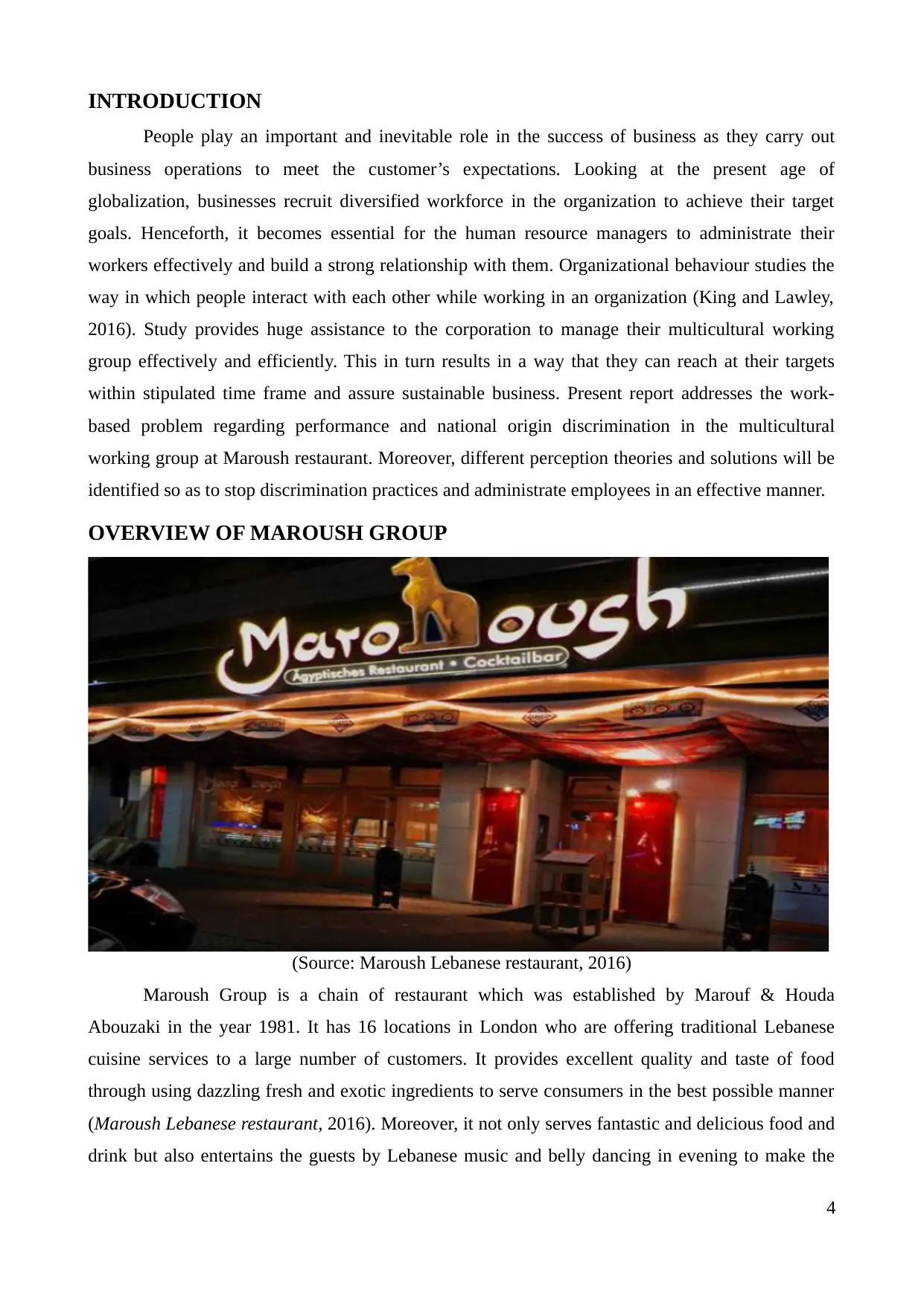
INTRODUCTION
People play an important and inevitable role in the success of business as they carry out
business operations to meet the customer’s expectations. Looking at the present age of
globalization, businesses recruit diversified workforce in the organization to achieve their target
goals. Henceforth, it becomes essential for the human resource managers to administrate their
workers effectively and build a strong relationship with them. Organizational behaviour studies the
way in which people interact with each other while working in an organization (King and Lawley,
2016). Study provides huge assistance to the corporation to manage their multicultural working
group effectively and efficiently. This in turn results in a way that they can reach at their targets
within stipulated time frame and assure sustainable business. Present report addresses the work-
based problem regarding performance and national origin discrimination in the multicultural
working group at Maroush restaurant. Moreover, different perception theories and solutions will be
identified so as to stop discrimination practices and administrate employees in an effective manner.
OVERVIEW OF MAROUSH GROUP
(Source: Maroush Lebanese restaurant, 2016)
Maroush Group is a chain of restaurant which was established by Marouf & Houda
Abouzaki in the year 1981. It has 16 locations in London who are offering traditional Lebanese
cuisine services to a large number of customers. It provides excellent quality and taste of food
through using dazzling fresh and exotic ingredients to serve consumers in the best possible manner
(Maroush Lebanese restaurant, 2016). Moreover, it not only serves fantastic and delicious food and
drink but also entertains the guests by Lebanese music and belly dancing in evening to make the
4
People play an important and inevitable role in the success of business as they carry out
business operations to meet the customer’s expectations. Looking at the present age of
globalization, businesses recruit diversified workforce in the organization to achieve their target
goals. Henceforth, it becomes essential for the human resource managers to administrate their
workers effectively and build a strong relationship with them. Organizational behaviour studies the
way in which people interact with each other while working in an organization (King and Lawley,
2016). Study provides huge assistance to the corporation to manage their multicultural working
group effectively and efficiently. This in turn results in a way that they can reach at their targets
within stipulated time frame and assure sustainable business. Present report addresses the work-
based problem regarding performance and national origin discrimination in the multicultural
working group at Maroush restaurant. Moreover, different perception theories and solutions will be
identified so as to stop discrimination practices and administrate employees in an effective manner.
OVERVIEW OF MAROUSH GROUP
(Source: Maroush Lebanese restaurant, 2016)
Maroush Group is a chain of restaurant which was established by Marouf & Houda
Abouzaki in the year 1981. It has 16 locations in London who are offering traditional Lebanese
cuisine services to a large number of customers. It provides excellent quality and taste of food
through using dazzling fresh and exotic ingredients to serve consumers in the best possible manner
(Maroush Lebanese restaurant, 2016). Moreover, it not only serves fantastic and delicious food and
drink but also entertains the guests by Lebanese music and belly dancing in evening to make the
4
Paraphrase This Document
Need a fresh take? Get an instant paraphrase of this document with our AI Paraphraser
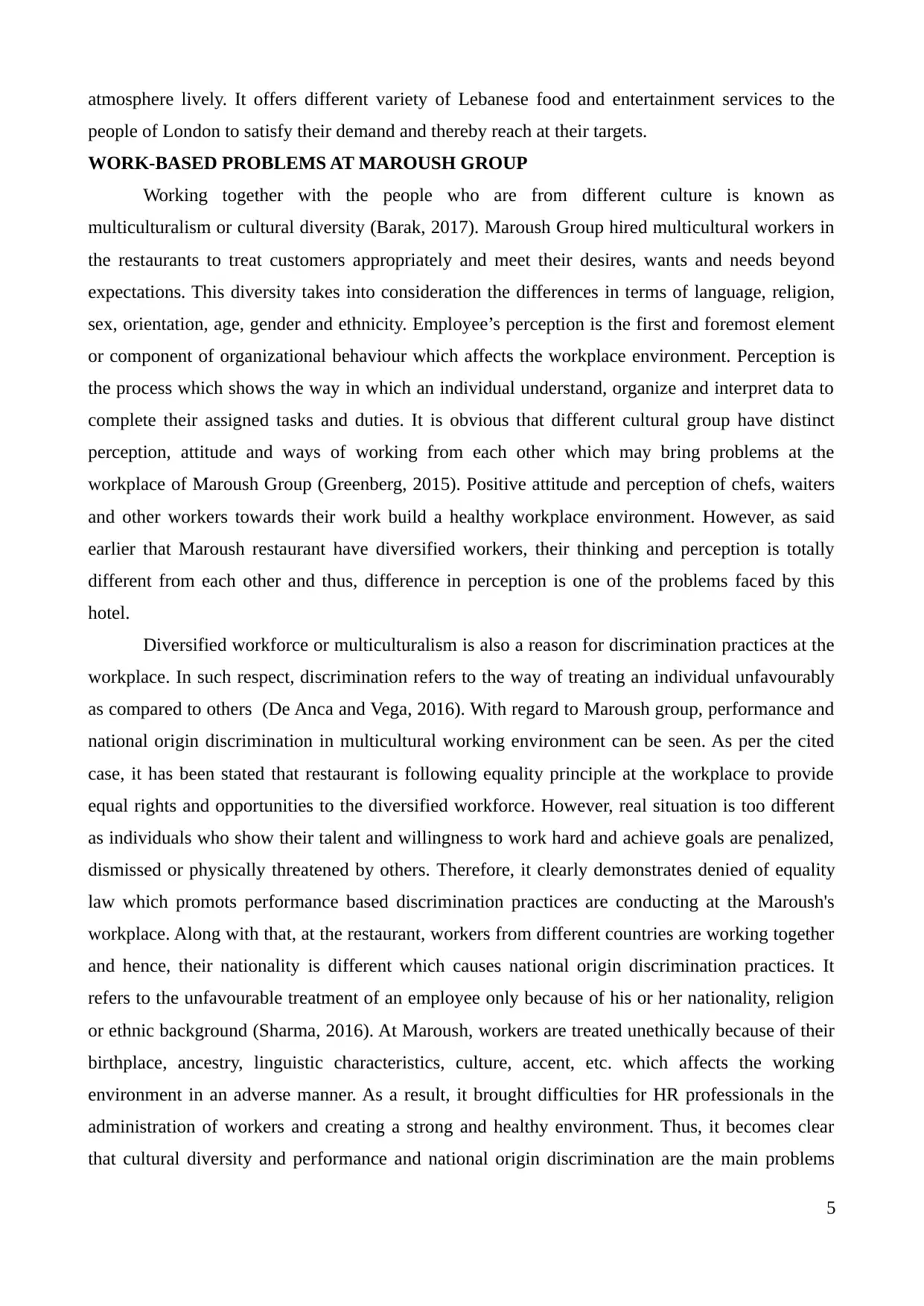
atmosphere lively. It offers different variety of Lebanese food and entertainment services to the
people of London to satisfy their demand and thereby reach at their targets.
WORK-BASED PROBLEMS AT MAROUSH GROUP
Working together with the people who are from different culture is known as
multiculturalism or cultural diversity (Barak, 2017). Maroush Group hired multicultural workers in
the restaurants to treat customers appropriately and meet their desires, wants and needs beyond
expectations. This diversity takes into consideration the differences in terms of language, religion,
sex, orientation, age, gender and ethnicity. Employee’s perception is the first and foremost element
or component of organizational behaviour which affects the workplace environment. Perception is
the process which shows the way in which an individual understand, organize and interpret data to
complete their assigned tasks and duties. It is obvious that different cultural group have distinct
perception, attitude and ways of working from each other which may bring problems at the
workplace of Maroush Group (Greenberg, 2015). Positive attitude and perception of chefs, waiters
and other workers towards their work build a healthy workplace environment. However, as said
earlier that Maroush restaurant have diversified workers, their thinking and perception is totally
different from each other and thus, difference in perception is one of the problems faced by this
hotel.
Diversified workforce or multiculturalism is also a reason for discrimination practices at the
workplace. In such respect, discrimination refers to the way of treating an individual unfavourably
as compared to others (De Anca and Vega, 2016). With regard to Maroush group, performance and
national origin discrimination in multicultural working environment can be seen. As per the cited
case, it has been stated that restaurant is following equality principle at the workplace to provide
equal rights and opportunities to the diversified workforce. However, real situation is too different
as individuals who show their talent and willingness to work hard and achieve goals are penalized,
dismissed or physically threatened by others. Therefore, it clearly demonstrates denied of equality
law which promots performance based discrimination practices are conducting at the Maroush's
workplace. Along with that, at the restaurant, workers from different countries are working together
and hence, their nationality is different which causes national origin discrimination practices. It
refers to the unfavourable treatment of an employee only because of his or her nationality, religion
or ethnic background (Sharma, 2016). At Maroush, workers are treated unethically because of their
birthplace, ancestry, linguistic characteristics, culture, accent, etc. which affects the working
environment in an adverse manner. As a result, it brought difficulties for HR professionals in the
administration of workers and creating a strong and healthy environment. Thus, it becomes clear
that cultural diversity and performance and national origin discrimination are the main problems
5
people of London to satisfy their demand and thereby reach at their targets.
WORK-BASED PROBLEMS AT MAROUSH GROUP
Working together with the people who are from different culture is known as
multiculturalism or cultural diversity (Barak, 2017). Maroush Group hired multicultural workers in
the restaurants to treat customers appropriately and meet their desires, wants and needs beyond
expectations. This diversity takes into consideration the differences in terms of language, religion,
sex, orientation, age, gender and ethnicity. Employee’s perception is the first and foremost element
or component of organizational behaviour which affects the workplace environment. Perception is
the process which shows the way in which an individual understand, organize and interpret data to
complete their assigned tasks and duties. It is obvious that different cultural group have distinct
perception, attitude and ways of working from each other which may bring problems at the
workplace of Maroush Group (Greenberg, 2015). Positive attitude and perception of chefs, waiters
and other workers towards their work build a healthy workplace environment. However, as said
earlier that Maroush restaurant have diversified workers, their thinking and perception is totally
different from each other and thus, difference in perception is one of the problems faced by this
hotel.
Diversified workforce or multiculturalism is also a reason for discrimination practices at the
workplace. In such respect, discrimination refers to the way of treating an individual unfavourably
as compared to others (De Anca and Vega, 2016). With regard to Maroush group, performance and
national origin discrimination in multicultural working environment can be seen. As per the cited
case, it has been stated that restaurant is following equality principle at the workplace to provide
equal rights and opportunities to the diversified workforce. However, real situation is too different
as individuals who show their talent and willingness to work hard and achieve goals are penalized,
dismissed or physically threatened by others. Therefore, it clearly demonstrates denied of equality
law which promots performance based discrimination practices are conducting at the Maroush's
workplace. Along with that, at the restaurant, workers from different countries are working together
and hence, their nationality is different which causes national origin discrimination practices. It
refers to the unfavourable treatment of an employee only because of his or her nationality, religion
or ethnic background (Sharma, 2016). At Maroush, workers are treated unethically because of their
birthplace, ancestry, linguistic characteristics, culture, accent, etc. which affects the working
environment in an adverse manner. As a result, it brought difficulties for HR professionals in the
administration of workers and creating a strong and healthy environment. Thus, it becomes clear
that cultural diversity and performance and national origin discrimination are the main problems
5
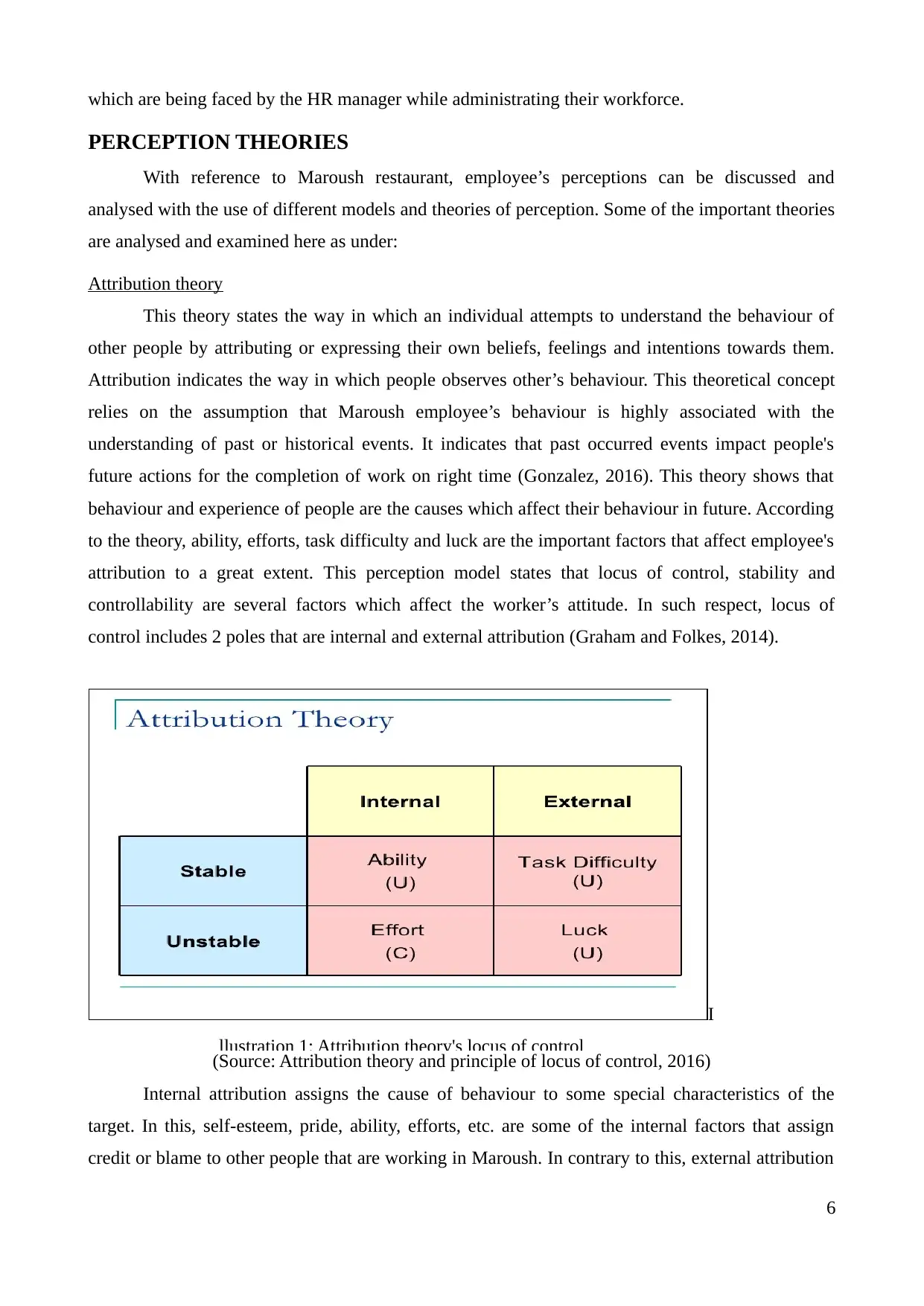
which are being faced by the HR manager while administrating their workforce.
PERCEPTION THEORIES
With reference to Maroush restaurant, employee’s perceptions can be discussed and
analysed with the use of different models and theories of perception. Some of the important theories
are analysed and examined here as under:
Attribution theory
This theory states the way in which an individual attempts to understand the behaviour of
other people by attributing or expressing their own beliefs, feelings and intentions towards them.
Attribution indicates the way in which people observes other’s behaviour. This theoretical concept
relies on the assumption that Maroush employee’s behaviour is highly associated with the
understanding of past or historical events. It indicates that past occurred events impact people's
future actions for the completion of work on right time (Gonzalez, 2016). This theory shows that
behaviour and experience of people are the causes which affect their behaviour in future. According
to the theory, ability, efforts, task difficulty and luck are the important factors that affect employee's
attribution to a great extent. This perception model states that locus of control, stability and
controllability are several factors which affect the worker’s attitude. In such respect, locus of
control includes 2 poles that are internal and external attribution (Graham and Folkes, 2014).
I
llustration 1: Attribution theory's locus of control
(Source: Attribution theory and principle of locus of control, 2016)
Internal attribution assigns the cause of behaviour to some special characteristics of the
target. In this, self-esteem, pride, ability, efforts, etc. are some of the internal factors that assign
credit or blame to other people that are working in Maroush. In contrary to this, external attribution
6
PERCEPTION THEORIES
With reference to Maroush restaurant, employee’s perceptions can be discussed and
analysed with the use of different models and theories of perception. Some of the important theories
are analysed and examined here as under:
Attribution theory
This theory states the way in which an individual attempts to understand the behaviour of
other people by attributing or expressing their own beliefs, feelings and intentions towards them.
Attribution indicates the way in which people observes other’s behaviour. This theoretical concept
relies on the assumption that Maroush employee’s behaviour is highly associated with the
understanding of past or historical events. It indicates that past occurred events impact people's
future actions for the completion of work on right time (Gonzalez, 2016). This theory shows that
behaviour and experience of people are the causes which affect their behaviour in future. According
to the theory, ability, efforts, task difficulty and luck are the important factors that affect employee's
attribution to a great extent. This perception model states that locus of control, stability and
controllability are several factors which affect the worker’s attitude. In such respect, locus of
control includes 2 poles that are internal and external attribution (Graham and Folkes, 2014).
I
llustration 1: Attribution theory's locus of control
(Source: Attribution theory and principle of locus of control, 2016)
Internal attribution assigns the cause of behaviour to some special characteristics of the
target. In this, self-esteem, pride, ability, efforts, etc. are some of the internal factors that assign
credit or blame to other people that are working in Maroush. In contrary to this, external attribution
6
⊘ This is a preview!⊘
Do you want full access?
Subscribe today to unlock all pages.

Trusted by 1+ million students worldwide
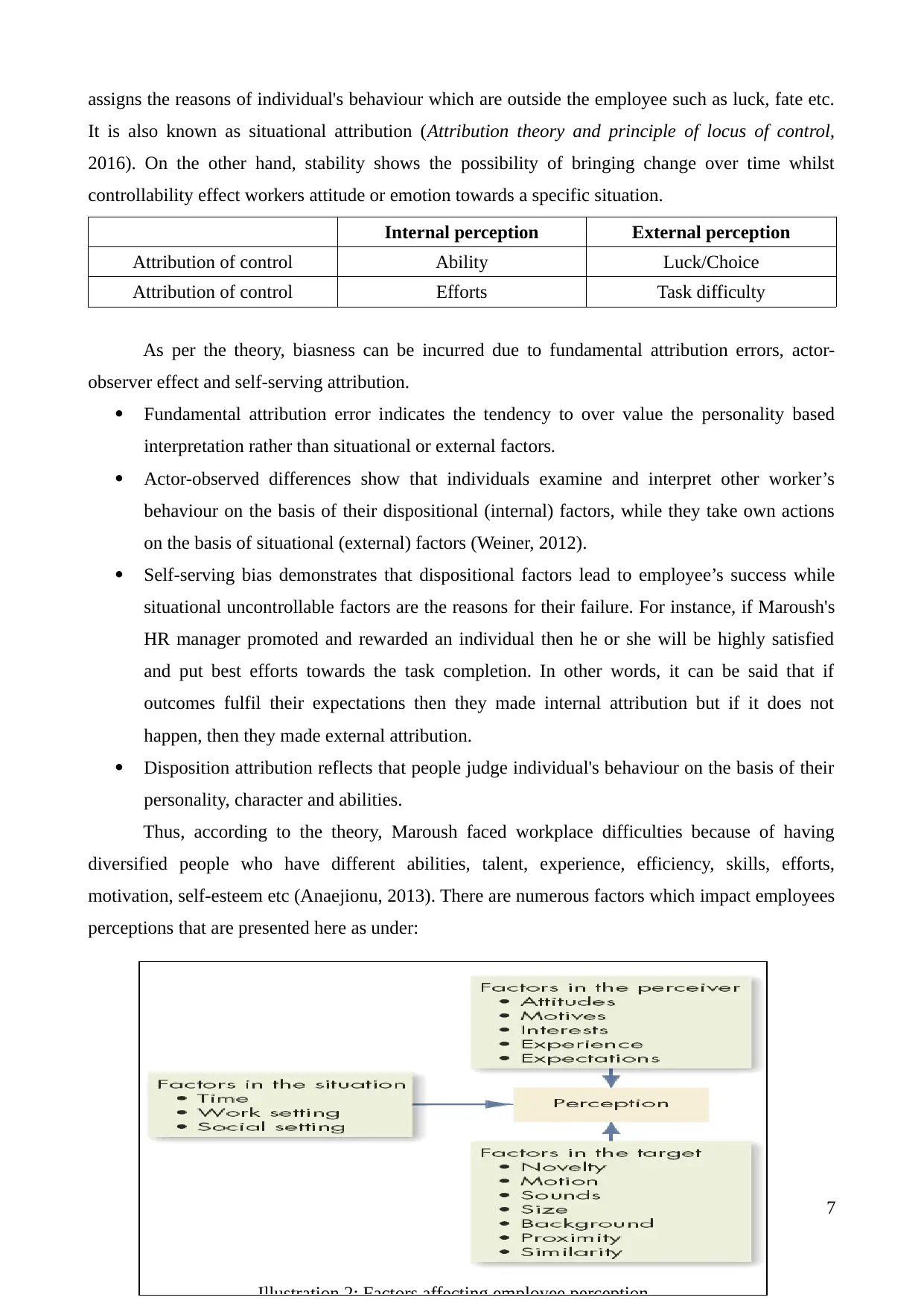
assigns the reasons of individual's behaviour which are outside the employee such as luck, fate etc.
It is also known as situational attribution (Attribution theory and principle of locus of control,
2016). On the other hand, stability shows the possibility of bringing change over time whilst
controllability effect workers attitude or emotion towards a specific situation.
Internal perception External perception
Attribution of control Ability Luck/Choice
Attribution of control Efforts Task difficulty
As per the theory, biasness can be incurred due to fundamental attribution errors, actor-
observer effect and self-serving attribution.
Fundamental attribution error indicates the tendency to over value the personality based
interpretation rather than situational or external factors.
Actor-observed differences show that individuals examine and interpret other worker’s
behaviour on the basis of their dispositional (internal) factors, while they take own actions
on the basis of situational (external) factors (Weiner, 2012).
Self-serving bias demonstrates that dispositional factors lead to employee’s success while
situational uncontrollable factors are the reasons for their failure. For instance, if Maroush's
HR manager promoted and rewarded an individual then he or she will be highly satisfied
and put best efforts towards the task completion. In other words, it can be said that if
outcomes fulfil their expectations then they made internal attribution but if it does not
happen, then they made external attribution.
Disposition attribution reflects that people judge individual's behaviour on the basis of their
personality, character and abilities.
Thus, according to the theory, Maroush faced workplace difficulties because of having
diversified people who have different abilities, talent, experience, efficiency, skills, efforts,
motivation, self-esteem etc (Anaejionu, 2013). There are numerous factors which impact employees
perceptions that are presented here as under:
7
Illustration 2: Factors affecting employee perception
It is also known as situational attribution (Attribution theory and principle of locus of control,
2016). On the other hand, stability shows the possibility of bringing change over time whilst
controllability effect workers attitude or emotion towards a specific situation.
Internal perception External perception
Attribution of control Ability Luck/Choice
Attribution of control Efforts Task difficulty
As per the theory, biasness can be incurred due to fundamental attribution errors, actor-
observer effect and self-serving attribution.
Fundamental attribution error indicates the tendency to over value the personality based
interpretation rather than situational or external factors.
Actor-observed differences show that individuals examine and interpret other worker’s
behaviour on the basis of their dispositional (internal) factors, while they take own actions
on the basis of situational (external) factors (Weiner, 2012).
Self-serving bias demonstrates that dispositional factors lead to employee’s success while
situational uncontrollable factors are the reasons for their failure. For instance, if Maroush's
HR manager promoted and rewarded an individual then he or she will be highly satisfied
and put best efforts towards the task completion. In other words, it can be said that if
outcomes fulfil their expectations then they made internal attribution but if it does not
happen, then they made external attribution.
Disposition attribution reflects that people judge individual's behaviour on the basis of their
personality, character and abilities.
Thus, according to the theory, Maroush faced workplace difficulties because of having
diversified people who have different abilities, talent, experience, efficiency, skills, efforts,
motivation, self-esteem etc (Anaejionu, 2013). There are numerous factors which impact employees
perceptions that are presented here as under:
7
Illustration 2: Factors affecting employee perception
Paraphrase This Document
Need a fresh take? Get an instant paraphrase of this document with our AI Paraphraser
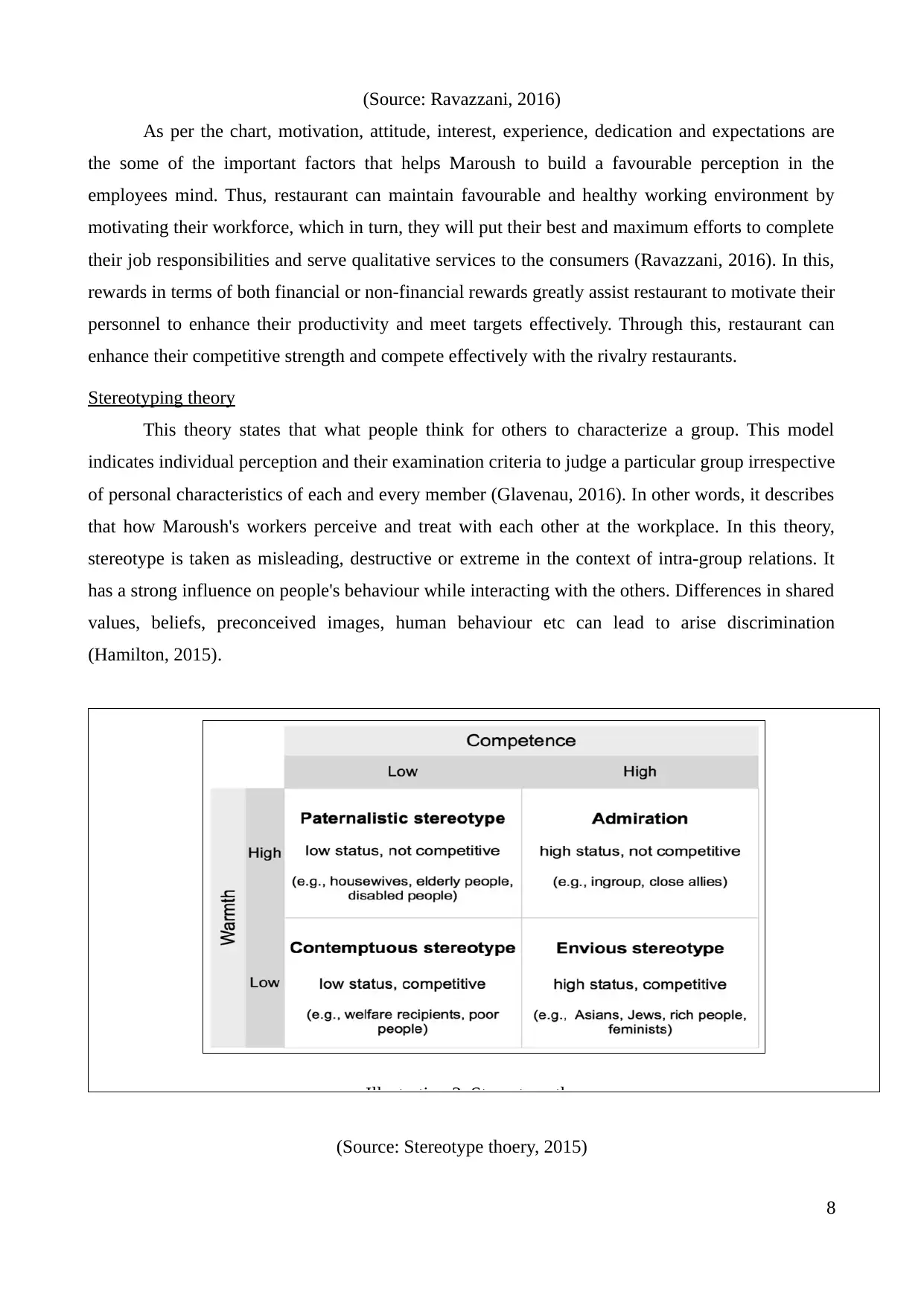
(Source: Ravazzani, 2016)
As per the chart, motivation, attitude, interest, experience, dedication and expectations are
the some of the important factors that helps Maroush to build a favourable perception in the
employees mind. Thus, restaurant can maintain favourable and healthy working environment by
motivating their workforce, which in turn, they will put their best and maximum efforts to complete
their job responsibilities and serve qualitative services to the consumers (Ravazzani, 2016). In this,
rewards in terms of both financial or non-financial rewards greatly assist restaurant to motivate their
personnel to enhance their productivity and meet targets effectively. Through this, restaurant can
enhance their competitive strength and compete effectively with the rivalry restaurants.
Stereotyping theory
This theory states that what people think for others to characterize a group. This model
indicates individual perception and their examination criteria to judge a particular group irrespective
of personal characteristics of each and every member (Glavenau, 2016). In other words, it describes
that how Maroush's workers perceive and treat with each other at the workplace. In this theory,
stereotype is taken as misleading, destructive or extreme in the context of intra-group relations. It
has a strong influence on people's behaviour while interacting with the others. Differences in shared
values, beliefs, preconceived images, human behaviour etc can lead to arise discrimination
(Hamilton, 2015).
Illustration 3: Stereotype theory
(Source: Stereotype thoery, 2015)
8
As per the chart, motivation, attitude, interest, experience, dedication and expectations are
the some of the important factors that helps Maroush to build a favourable perception in the
employees mind. Thus, restaurant can maintain favourable and healthy working environment by
motivating their workforce, which in turn, they will put their best and maximum efforts to complete
their job responsibilities and serve qualitative services to the consumers (Ravazzani, 2016). In this,
rewards in terms of both financial or non-financial rewards greatly assist restaurant to motivate their
personnel to enhance their productivity and meet targets effectively. Through this, restaurant can
enhance their competitive strength and compete effectively with the rivalry restaurants.
Stereotyping theory
This theory states that what people think for others to characterize a group. This model
indicates individual perception and their examination criteria to judge a particular group irrespective
of personal characteristics of each and every member (Glavenau, 2016). In other words, it describes
that how Maroush's workers perceive and treat with each other at the workplace. In this theory,
stereotype is taken as misleading, destructive or extreme in the context of intra-group relations. It
has a strong influence on people's behaviour while interacting with the others. Differences in shared
values, beliefs, preconceived images, human behaviour etc can lead to arise discrimination
(Hamilton, 2015).
Illustration 3: Stereotype theory
(Source: Stereotype thoery, 2015)
8
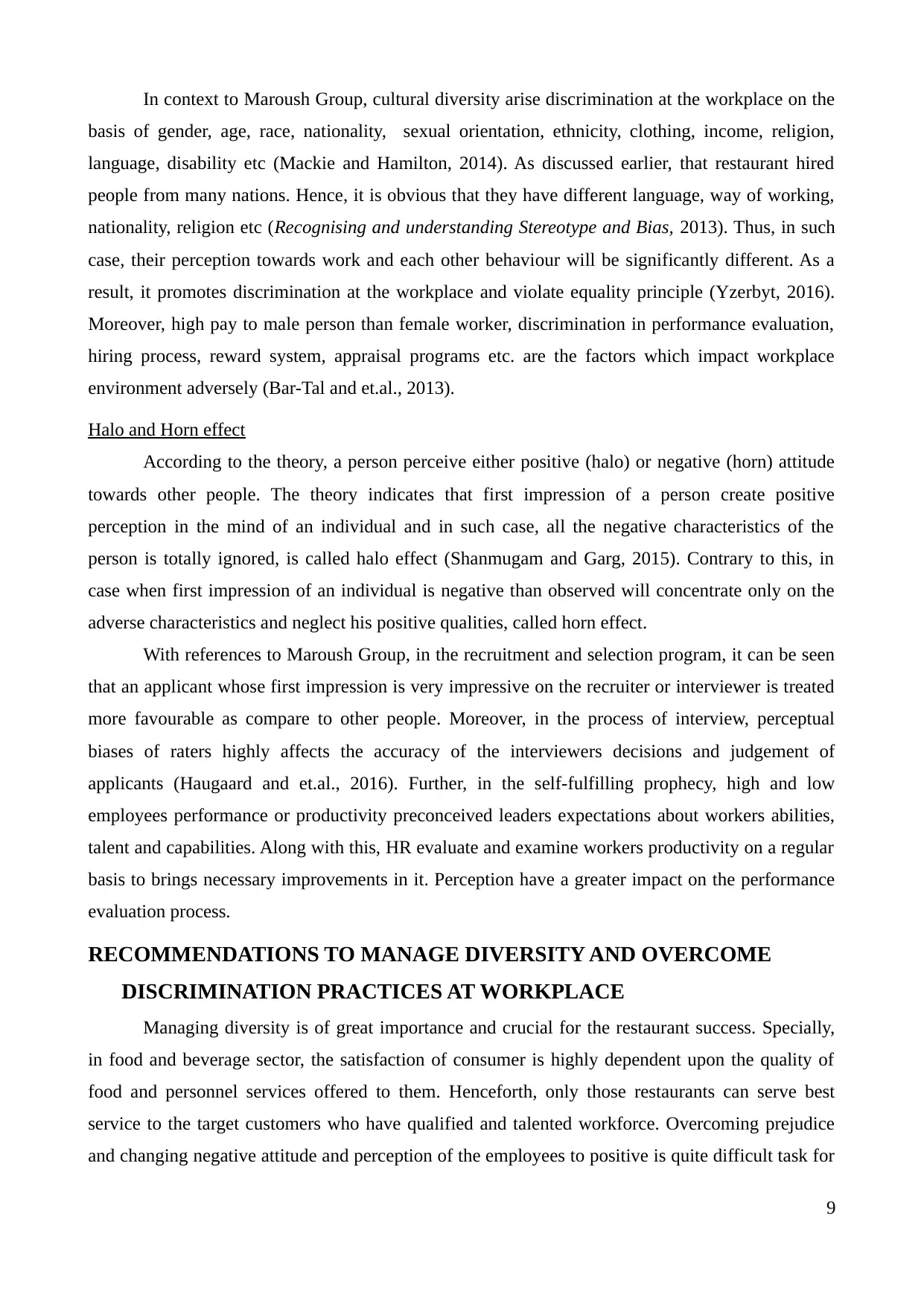
In context to Maroush Group, cultural diversity arise discrimination at the workplace on the
basis of gender, age, race, nationality, sexual orientation, ethnicity, clothing, income, religion,
language, disability etc (Mackie and Hamilton, 2014). As discussed earlier, that restaurant hired
people from many nations. Hence, it is obvious that they have different language, way of working,
nationality, religion etc (Recognising and understanding Stereotype and Bias, 2013). Thus, in such
case, their perception towards work and each other behaviour will be significantly different. As a
result, it promotes discrimination at the workplace and violate equality principle (Yzerbyt, 2016).
Moreover, high pay to male person than female worker, discrimination in performance evaluation,
hiring process, reward system, appraisal programs etc. are the factors which impact workplace
environment adversely (Bar-Tal and et.al., 2013).
Halo and Horn effect
According to the theory, a person perceive either positive (halo) or negative (horn) attitude
towards other people. The theory indicates that first impression of a person create positive
perception in the mind of an individual and in such case, all the negative characteristics of the
person is totally ignored, is called halo effect (Shanmugam and Garg, 2015). Contrary to this, in
case when first impression of an individual is negative than observed will concentrate only on the
adverse characteristics and neglect his positive qualities, called horn effect.
With references to Maroush Group, in the recruitment and selection program, it can be seen
that an applicant whose first impression is very impressive on the recruiter or interviewer is treated
more favourable as compare to other people. Moreover, in the process of interview, perceptual
biases of raters highly affects the accuracy of the interviewers decisions and judgement of
applicants (Haugaard and et.al., 2016). Further, in the self-fulfilling prophecy, high and low
employees performance or productivity preconceived leaders expectations about workers abilities,
talent and capabilities. Along with this, HR evaluate and examine workers productivity on a regular
basis to brings necessary improvements in it. Perception have a greater impact on the performance
evaluation process.
RECOMMENDATIONS TO MANAGE DIVERSITY AND OVERCOME
DISCRIMINATION PRACTICES AT WORKPLACE
Managing diversity is of great importance and crucial for the restaurant success. Specially,
in food and beverage sector, the satisfaction of consumer is highly dependent upon the quality of
food and personnel services offered to them. Henceforth, only those restaurants can serve best
service to the target customers who have qualified and talented workforce. Overcoming prejudice
and changing negative attitude and perception of the employees to positive is quite difficult task for
9
basis of gender, age, race, nationality, sexual orientation, ethnicity, clothing, income, religion,
language, disability etc (Mackie and Hamilton, 2014). As discussed earlier, that restaurant hired
people from many nations. Hence, it is obvious that they have different language, way of working,
nationality, religion etc (Recognising and understanding Stereotype and Bias, 2013). Thus, in such
case, their perception towards work and each other behaviour will be significantly different. As a
result, it promotes discrimination at the workplace and violate equality principle (Yzerbyt, 2016).
Moreover, high pay to male person than female worker, discrimination in performance evaluation,
hiring process, reward system, appraisal programs etc. are the factors which impact workplace
environment adversely (Bar-Tal and et.al., 2013).
Halo and Horn effect
According to the theory, a person perceive either positive (halo) or negative (horn) attitude
towards other people. The theory indicates that first impression of a person create positive
perception in the mind of an individual and in such case, all the negative characteristics of the
person is totally ignored, is called halo effect (Shanmugam and Garg, 2015). Contrary to this, in
case when first impression of an individual is negative than observed will concentrate only on the
adverse characteristics and neglect his positive qualities, called horn effect.
With references to Maroush Group, in the recruitment and selection program, it can be seen
that an applicant whose first impression is very impressive on the recruiter or interviewer is treated
more favourable as compare to other people. Moreover, in the process of interview, perceptual
biases of raters highly affects the accuracy of the interviewers decisions and judgement of
applicants (Haugaard and et.al., 2016). Further, in the self-fulfilling prophecy, high and low
employees performance or productivity preconceived leaders expectations about workers abilities,
talent and capabilities. Along with this, HR evaluate and examine workers productivity on a regular
basis to brings necessary improvements in it. Perception have a greater impact on the performance
evaluation process.
RECOMMENDATIONS TO MANAGE DIVERSITY AND OVERCOME
DISCRIMINATION PRACTICES AT WORKPLACE
Managing diversity is of great importance and crucial for the restaurant success. Specially,
in food and beverage sector, the satisfaction of consumer is highly dependent upon the quality of
food and personnel services offered to them. Henceforth, only those restaurants can serve best
service to the target customers who have qualified and talented workforce. Overcoming prejudice
and changing negative attitude and perception of the employees to positive is quite difficult task for
9
⊘ This is a preview!⊘
Do you want full access?
Subscribe today to unlock all pages.

Trusted by 1+ million students worldwide
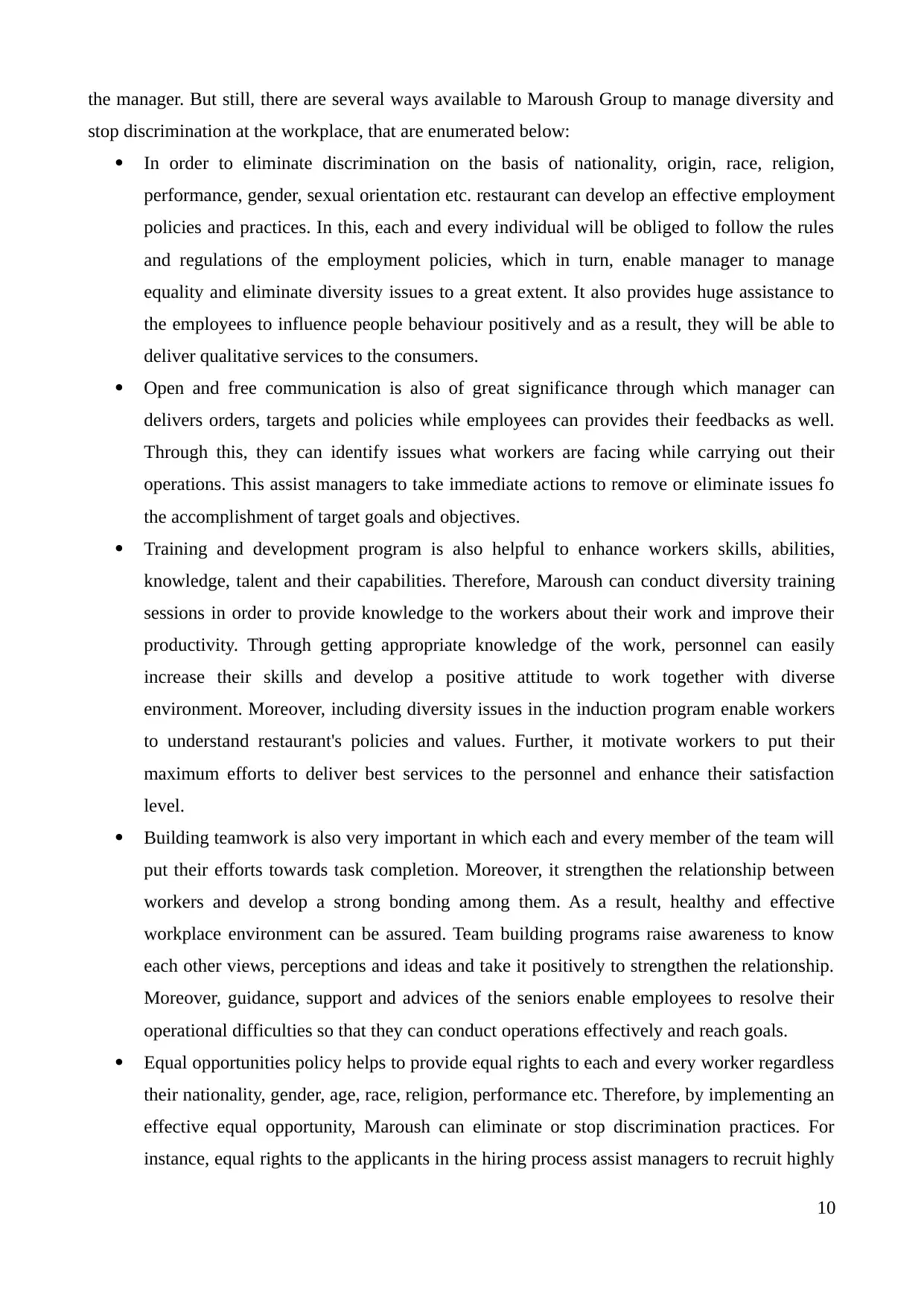
the manager. But still, there are several ways available to Maroush Group to manage diversity and
stop discrimination at the workplace, that are enumerated below:
In order to eliminate discrimination on the basis of nationality, origin, race, religion,
performance, gender, sexual orientation etc. restaurant can develop an effective employment
policies and practices. In this, each and every individual will be obliged to follow the rules
and regulations of the employment policies, which in turn, enable manager to manage
equality and eliminate diversity issues to a great extent. It also provides huge assistance to
the employees to influence people behaviour positively and as a result, they will be able to
deliver qualitative services to the consumers.
Open and free communication is also of great significance through which manager can
delivers orders, targets and policies while employees can provides their feedbacks as well.
Through this, they can identify issues what workers are facing while carrying out their
operations. This assist managers to take immediate actions to remove or eliminate issues fo
the accomplishment of target goals and objectives.
Training and development program is also helpful to enhance workers skills, abilities,
knowledge, talent and their capabilities. Therefore, Maroush can conduct diversity training
sessions in order to provide knowledge to the workers about their work and improve their
productivity. Through getting appropriate knowledge of the work, personnel can easily
increase their skills and develop a positive attitude to work together with diverse
environment. Moreover, including diversity issues in the induction program enable workers
to understand restaurant's policies and values. Further, it motivate workers to put their
maximum efforts to deliver best services to the personnel and enhance their satisfaction
level.
Building teamwork is also very important in which each and every member of the team will
put their efforts towards task completion. Moreover, it strengthen the relationship between
workers and develop a strong bonding among them. As a result, healthy and effective
workplace environment can be assured. Team building programs raise awareness to know
each other views, perceptions and ideas and take it positively to strengthen the relationship.
Moreover, guidance, support and advices of the seniors enable employees to resolve their
operational difficulties so that they can conduct operations effectively and reach goals.
Equal opportunities policy helps to provide equal rights to each and every worker regardless
their nationality, gender, age, race, religion, performance etc. Therefore, by implementing an
effective equal opportunity, Maroush can eliminate or stop discrimination practices. For
instance, equal rights to the applicants in the hiring process assist managers to recruit highly
10
stop discrimination at the workplace, that are enumerated below:
In order to eliminate discrimination on the basis of nationality, origin, race, religion,
performance, gender, sexual orientation etc. restaurant can develop an effective employment
policies and practices. In this, each and every individual will be obliged to follow the rules
and regulations of the employment policies, which in turn, enable manager to manage
equality and eliminate diversity issues to a great extent. It also provides huge assistance to
the employees to influence people behaviour positively and as a result, they will be able to
deliver qualitative services to the consumers.
Open and free communication is also of great significance through which manager can
delivers orders, targets and policies while employees can provides their feedbacks as well.
Through this, they can identify issues what workers are facing while carrying out their
operations. This assist managers to take immediate actions to remove or eliminate issues fo
the accomplishment of target goals and objectives.
Training and development program is also helpful to enhance workers skills, abilities,
knowledge, talent and their capabilities. Therefore, Maroush can conduct diversity training
sessions in order to provide knowledge to the workers about their work and improve their
productivity. Through getting appropriate knowledge of the work, personnel can easily
increase their skills and develop a positive attitude to work together with diverse
environment. Moreover, including diversity issues in the induction program enable workers
to understand restaurant's policies and values. Further, it motivate workers to put their
maximum efforts to deliver best services to the personnel and enhance their satisfaction
level.
Building teamwork is also very important in which each and every member of the team will
put their efforts towards task completion. Moreover, it strengthen the relationship between
workers and develop a strong bonding among them. As a result, healthy and effective
workplace environment can be assured. Team building programs raise awareness to know
each other views, perceptions and ideas and take it positively to strengthen the relationship.
Moreover, guidance, support and advices of the seniors enable employees to resolve their
operational difficulties so that they can conduct operations effectively and reach goals.
Equal opportunities policy helps to provide equal rights to each and every worker regardless
their nationality, gender, age, race, religion, performance etc. Therefore, by implementing an
effective equal opportunity, Maroush can eliminate or stop discrimination practices. For
instance, equal rights to the applicants in the hiring process assist managers to recruit highly
10
Paraphrase This Document
Need a fresh take? Get an instant paraphrase of this document with our AI Paraphraser
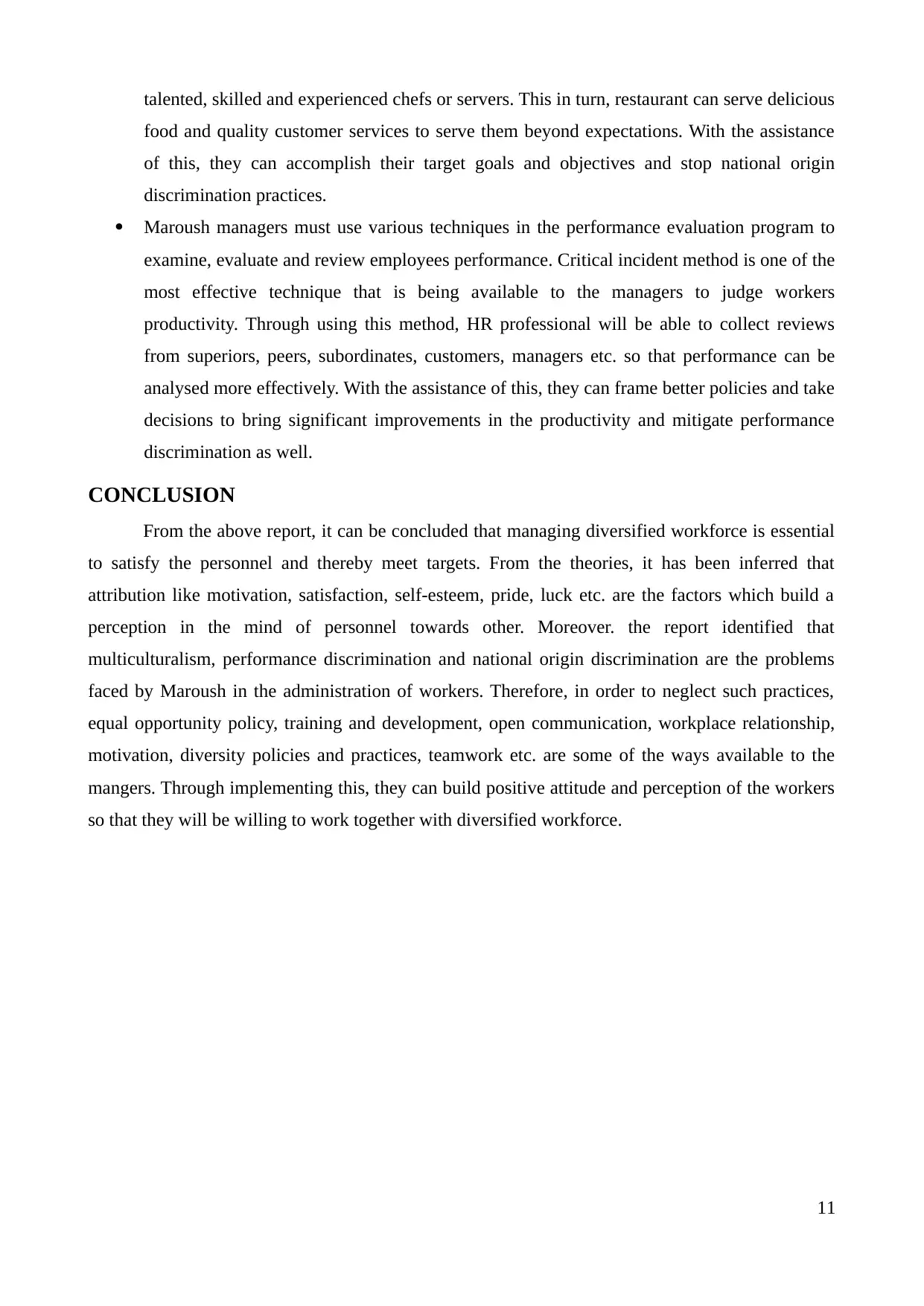
talented, skilled and experienced chefs or servers. This in turn, restaurant can serve delicious
food and quality customer services to serve them beyond expectations. With the assistance
of this, they can accomplish their target goals and objectives and stop national origin
discrimination practices.
Maroush managers must use various techniques in the performance evaluation program to
examine, evaluate and review employees performance. Critical incident method is one of the
most effective technique that is being available to the managers to judge workers
productivity. Through using this method, HR professional will be able to collect reviews
from superiors, peers, subordinates, customers, managers etc. so that performance can be
analysed more effectively. With the assistance of this, they can frame better policies and take
decisions to bring significant improvements in the productivity and mitigate performance
discrimination as well.
CONCLUSION
From the above report, it can be concluded that managing diversified workforce is essential
to satisfy the personnel and thereby meet targets. From the theories, it has been inferred that
attribution like motivation, satisfaction, self-esteem, pride, luck etc. are the factors which build a
perception in the mind of personnel towards other. Moreover. the report identified that
multiculturalism, performance discrimination and national origin discrimination are the problems
faced by Maroush in the administration of workers. Therefore, in order to neglect such practices,
equal opportunity policy, training and development, open communication, workplace relationship,
motivation, diversity policies and practices, teamwork etc. are some of the ways available to the
mangers. Through implementing this, they can build positive attitude and perception of the workers
so that they will be willing to work together with diversified workforce.
11
food and quality customer services to serve them beyond expectations. With the assistance
of this, they can accomplish their target goals and objectives and stop national origin
discrimination practices.
Maroush managers must use various techniques in the performance evaluation program to
examine, evaluate and review employees performance. Critical incident method is one of the
most effective technique that is being available to the managers to judge workers
productivity. Through using this method, HR professional will be able to collect reviews
from superiors, peers, subordinates, customers, managers etc. so that performance can be
analysed more effectively. With the assistance of this, they can frame better policies and take
decisions to bring significant improvements in the productivity and mitigate performance
discrimination as well.
CONCLUSION
From the above report, it can be concluded that managing diversified workforce is essential
to satisfy the personnel and thereby meet targets. From the theories, it has been inferred that
attribution like motivation, satisfaction, self-esteem, pride, luck etc. are the factors which build a
perception in the mind of personnel towards other. Moreover. the report identified that
multiculturalism, performance discrimination and national origin discrimination are the problems
faced by Maroush in the administration of workers. Therefore, in order to neglect such practices,
equal opportunity policy, training and development, open communication, workplace relationship,
motivation, diversity policies and practices, teamwork etc. are some of the ways available to the
mangers. Through implementing this, they can build positive attitude and perception of the workers
so that they will be willing to work together with diversified workforce.
11
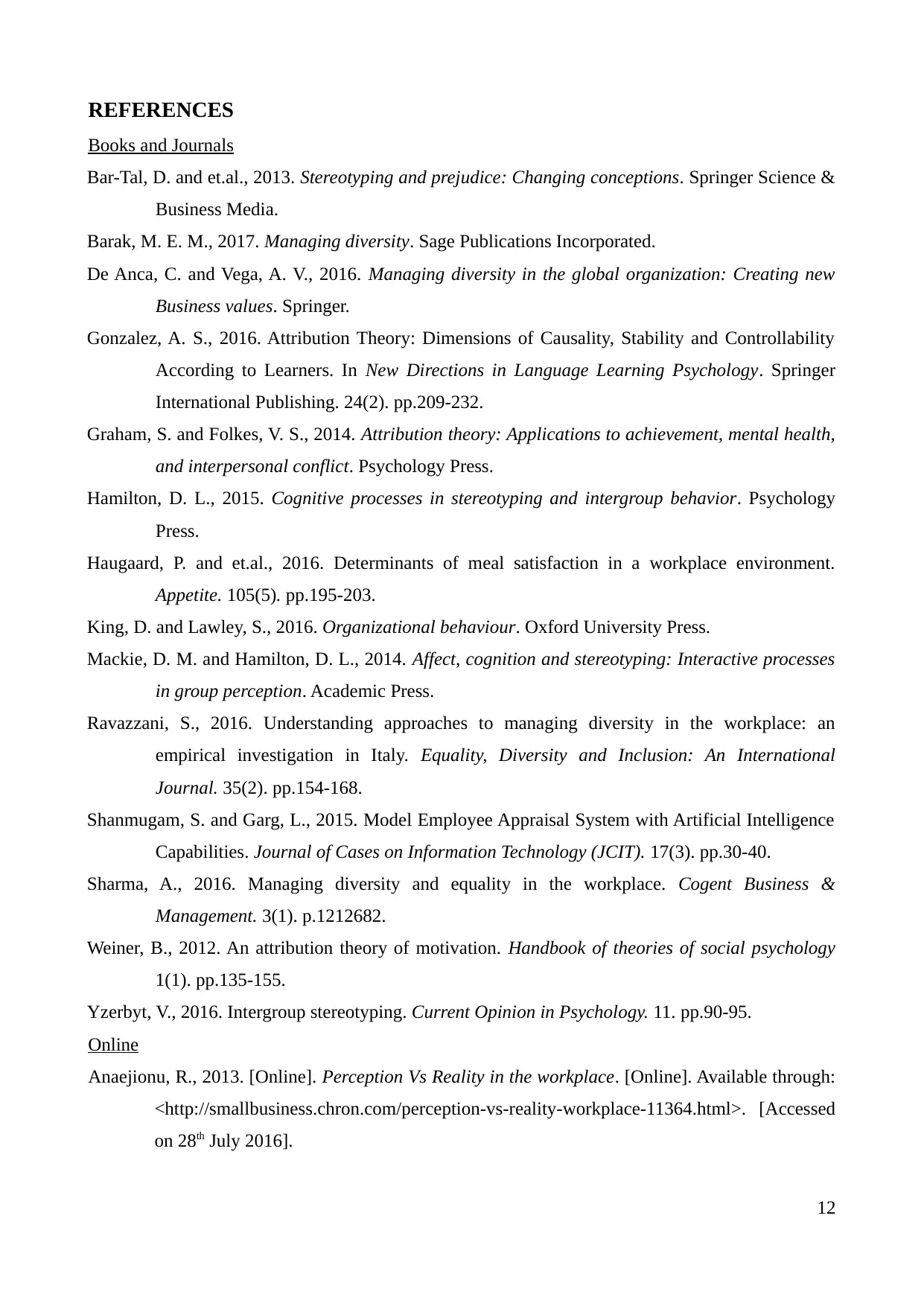
REFERENCES
Books and Journals
Bar-Tal, D. and et.al., 2013. Stereotyping and prejudice: Changing conceptions. Springer Science &
Business Media.
Barak, M. E. M., 2017. Managing diversity. Sage Publications Incorporated.
De Anca, C. and Vega, A. V., 2016. Managing diversity in the global organization: Creating new
Business values. Springer.
Gonzalez, A. S., 2016. Attribution Theory: Dimensions of Causality, Stability and Controllability
According to Learners. In New Directions in Language Learning Psychology. Springer
International Publishing. 24(2). pp.209-232.
Graham, S. and Folkes, V. S., 2014. Attribution theory: Applications to achievement, mental health,
and interpersonal conflict. Psychology Press.
Hamilton, D. L., 2015. Cognitive processes in stereotyping and intergroup behavior. Psychology
Press.
Haugaard, P. and et.al., 2016. Determinants of meal satisfaction in a workplace environment.
Appetite. 105(5). pp.195-203.
King, D. and Lawley, S., 2016. Organizational behaviour. Oxford University Press.
Mackie, D. M. and Hamilton, D. L., 2014. Affect, cognition and stereotyping: Interactive processes
in group perception. Academic Press.
Ravazzani, S., 2016. Understanding approaches to managing diversity in the workplace: an
empirical investigation in Italy. Equality, Diversity and Inclusion: An International
Journal. 35(2). pp.154-168.
Shanmugam, S. and Garg, L., 2015. Model Employee Appraisal System with Artificial Intelligence
Capabilities. Journal of Cases on Information Technology (JCIT). 17(3). pp.30-40.
Sharma, A., 2016. Managing diversity and equality in the workplace. Cogent Business &
Management. 3(1). p.1212682.
Weiner, B., 2012. An attribution theory of motivation. Handbook of theories of social psychology
1(1). pp.135-155.
Yzerbyt, V., 2016. Intergroup stereotyping. Current Opinion in Psychology. 11. pp.90-95.
Online
Anaejionu, R., 2013. [Online]. Perception Vs Reality in the workplace. [Online]. Available through:
<http://smallbusiness.chron.com/perception-vs-reality-workplace-11364.html>. [Accessed
on 28th July 2016].
12
Books and Journals
Bar-Tal, D. and et.al., 2013. Stereotyping and prejudice: Changing conceptions. Springer Science &
Business Media.
Barak, M. E. M., 2017. Managing diversity. Sage Publications Incorporated.
De Anca, C. and Vega, A. V., 2016. Managing diversity in the global organization: Creating new
Business values. Springer.
Gonzalez, A. S., 2016. Attribution Theory: Dimensions of Causality, Stability and Controllability
According to Learners. In New Directions in Language Learning Psychology. Springer
International Publishing. 24(2). pp.209-232.
Graham, S. and Folkes, V. S., 2014. Attribution theory: Applications to achievement, mental health,
and interpersonal conflict. Psychology Press.
Hamilton, D. L., 2015. Cognitive processes in stereotyping and intergroup behavior. Psychology
Press.
Haugaard, P. and et.al., 2016. Determinants of meal satisfaction in a workplace environment.
Appetite. 105(5). pp.195-203.
King, D. and Lawley, S., 2016. Organizational behaviour. Oxford University Press.
Mackie, D. M. and Hamilton, D. L., 2014. Affect, cognition and stereotyping: Interactive processes
in group perception. Academic Press.
Ravazzani, S., 2016. Understanding approaches to managing diversity in the workplace: an
empirical investigation in Italy. Equality, Diversity and Inclusion: An International
Journal. 35(2). pp.154-168.
Shanmugam, S. and Garg, L., 2015. Model Employee Appraisal System with Artificial Intelligence
Capabilities. Journal of Cases on Information Technology (JCIT). 17(3). pp.30-40.
Sharma, A., 2016. Managing diversity and equality in the workplace. Cogent Business &
Management. 3(1). p.1212682.
Weiner, B., 2012. An attribution theory of motivation. Handbook of theories of social psychology
1(1). pp.135-155.
Yzerbyt, V., 2016. Intergroup stereotyping. Current Opinion in Psychology. 11. pp.90-95.
Online
Anaejionu, R., 2013. [Online]. Perception Vs Reality in the workplace. [Online]. Available through:
<http://smallbusiness.chron.com/perception-vs-reality-workplace-11364.html>. [Accessed
on 28th July 2016].
12
⊘ This is a preview!⊘
Do you want full access?
Subscribe today to unlock all pages.

Trusted by 1+ million students worldwide
1 out of 13
Related Documents
Your All-in-One AI-Powered Toolkit for Academic Success.
+13062052269
info@desklib.com
Available 24*7 on WhatsApp / Email
![[object Object]](/_next/static/media/star-bottom.7253800d.svg)
Unlock your academic potential
Copyright © 2020–2025 A2Z Services. All Rights Reserved. Developed and managed by ZUCOL.





